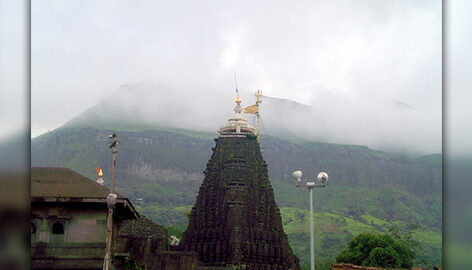

Nashik; is also spelt as Nasik, situated in the northern part of Maharashtra. Nasik is one of the most important cities of Maharashtra. The city is the centre of attraction for its beautiful surrounding and cool and pleasant climate. The History of Nashik is known for its mythological, historical, social, and cultural importance. It is one of the four cities that host the massive Sinhastha Kumbh Mela once every twelve years. River Godavari flows through the city; the temple Ghats on the bank of river Godavari; makes Nashik one of the holiest places for Hindus all over the World. City Nasik is surrounded; by nine hills, namely: Durga, Ganesh, Chitraghanta, Pandav, DingerAli, Mhasarul, Jogwada, Pathanpura, and Konkani.
Since the ancient period, it had been a seat of commerce and trade in India. The archaeological excavation had found that the territory around Nashik; was occupied in the early Stone Age. Archaeological sites like Pandu (Buddhist) and Chamar (Jain) temple cave; is situated in Nasik.
The history of Nashik has jotted down different names of the city during the different yugas. During the Satya Yuga, it is known, with the name of ‘Padmanagar’, during the ‘Tetra Yuga’ period, it is known, with the name of ‘Trikantak’, during the ‘Dvapara Yuga’ period it is known with the name of ‘Janasthana’, and ultimately during the ‘Kali Yuga’ period, it is known with the name of ‘Navashikh’ or ‘Nashik’. The city got its present name in the year 1818 CE when the Peshwas got hold of this city. Peshwa controlled this city for a short period, and later this city moved into the hands of the British Empire. When the Mughal grab this city, they named this city Gulshanabad due to its beauty. But, when Maratha regained this region in the year 1752, they renamed this city Nashik.
We can find the reference to the history of Nashik in Ramayana. In the Indian epic like Ramayana, Nasik; is also named ‘Panchavati’. When Lord Rama and Sita; was asked to leave Ayodha by Rama’s step-mother Kaikayi they both left. However, the love of elder brother Rama, Laxman also left Ayrodha with both these couples in exile for 14 years.
Rama, Sita, and Laxman stayed at Panchvati for some time due to this Panchavati, had gained holy importance. Panchavati got its name from five Banyan (Vad) tree because of the five great banyan trees, which grew there. Panchavati was a place where this trio made their home for exile. During their exile period Shoorpanaka, the sister of demon Raavan, tried to seduce Ram. Angered Ram; ordered Laxman to cut off the nose of Shoorpnaka and the city got its name as Nashik. There is a belief that Lord Vishnu defeated three demons here; hence the city; is also named ‘Tri-Kantak’.
Throughout the history of Nashik, The city was ruled; by many dynasties like the Mauryan Empire, Satvahanas, Abhiras, Traikutakas, Vishnukundins, Kalachuris, Chalukyas, Chalukyas of Badami, Rashtrakutas Dynasty, Yadavas.
Satavahana Rule in Nashik (207 BC – 199 CE)
After the death of Emperor Ashok, the Satavahana Empire came into power. The Satavahana Empire ruled Nashik during the rule of king. During the later period, many Satavahana territories like Malwa, Nashik, Kathiawar of Maharashtra, conquered by king Shaka of Western Kshatrapas. King Nahapana of Western Kshatrapas; had also ruled; the parts of Konkan, Poona, Nasik, and some other districts of Maharashtra, and some portion of Central India, as far north as Ajmer. It was king Nahapana who had excited Pandav-lene in Nashik. Satavahan Empire again got the hold on Nashik during the reign of Gautamiputra Satakarni. The Gautamiputra Satakarni of Satavahana Empire defeated Nahapana of Western Kshatrapas and brought the territory of Nashik under his control. After Gautamiputra Satkarni, his successor Yajnashri Satakarni was the most noteworthy ruler of the Satavahana Empire.
Rise of Abhiraka Dynasty (220 CE – 377 CE)
After the fall of the Satvahana Empire, Abhiraka Dynasty came into power. The Abhirakas ruled around 67 years; they ruled the northeast and the Chutes in Maharashtra and Kuntala. King Ishvarasena, son of Shivadatta, was the founder of the Abhira dynasty.
Traikutakas
The Traikutakas dynasty took their name from the mountain Trikuta, which borders the Nashik district on the west. The three Traikutakas kings are Indradatta, Dahrasena, and Vyaghrasena, known from the inscription and the coins found in Nasik district and Gujarat. The mention of Trikutas; are found in Kalidasa Raghuvamsa, in which they are located, in Nothern Konkan.
Vishnukundis
During the 6th century, when the Vakataka dynasty started diminishing, King Madhavavarman I of Vishnukundins occupied the Vidarbha region. Madhavavarman I; married the daughter of the last ruling king of the Vakataka dynasty; Harishena I. He took advantage of the weakness of the Vakataka Dynasty and extended his dominion far and wide. King Madhavavarman I performed many sacrifices, including eleven Ashvamedha. During his rule, he brought the region of Western Maharashtra under his control.
Kalachuri (550 CE-573 CE)
The Vishnukundins king was thrown out of Maharashtra and Vidarbha by the Kalachuri king Krishnaraja; in the year 550 CE. King Krishnaraja had ruled from Mahishmati, modern Maheshvara, in the former Indore State. Krishnaraja; was succeeded by his son Shankaragana; he extended his kingdom from Malva to Nasik and Aurangabad district in the south. After Shankaragana, his son Buddharaja Succeeded him. Buddharaja after sitting on the throne; involved in the struggle with Chalukya king Mangalesha on the southern frontier of his kingdom soon after his accession.
Some important points about Nashik
The Mintage World Team comprises of experts, researchers and writers from the field of Philately, Notaphily and Numismatics who try to shed light on some of the most interesting aspects of coins, banknotes and stamps from not just India but across the globe as well.